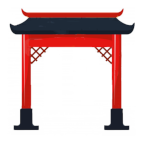| Meaning |

to stay, linger 夋
|
| Explanation |
|
Used in these characters:
|
|
俊
|
 |
|
JLPT HSK 5 |
|
| smart, eminent, handsome, talented
|
Left: person 人, right: dawdle 夋 (nose 厶, legs 儿, cross-legged 夂)
A person with such a nose, legs and contorted feet must be smart.

|
|
|
|
峻
|
 |
|
JLPT HSK 6 |
|
| (of mountains) high, harsh or severe
|
Left: mountain 山, right: dawdle = go slowly 夋 (nose 厶, legs 儿, upturned foot 夂)
A mountain, that has a nose, legs and an 'upturned foot' must be high and harsh.

|
|
|
|
唆
|
 |
|
JLPT HSK 6 |
|
| to instigate, incite, to stir up
|
Left: mouth 口, right: to dawdle 夋 (nose 厶, legs 儿, upturned foot 夂)
Mouth, nose, legs and an upturned foot: That shall instigate?

|
|
|
|
梭
|
 |
|
JLPT no HSK |
|
| to move back and forth, shuttle (textiles)
|
Left: tree 木, right: to dawdle 夋 (nose 厶, legs 儿, upturned foot 夂)
The wood, with a nose at the front, legs at the end and upturns is a shuttle (at the loom).

|
|
|
|
骏
|
 |
|
JLPT no HSK |
|
| spirited horse
|
Left: horse 马/馬 (= with mane, four legs 灬 and tail ㄅ), right: dawdle 夋 (nose 厶, legs 儿, upturned foot 夂)
A horse with this nose, legs and upturned feet must be spirited.

|
|
|
|
竣
|
 |
|
JLPT no HSK |
|
| complete, finish
|
Left: to stand 立, right: to dawdle =go slowly 夋 (nose 厶, legs 儿, upturned foot 夂)
(At the end of a race) You can stand (still) or dawdle when you have: completed or finished (the race).

|
|
|
|
浚
|
 |
|
JLPT no HSK |
|
| to deepen (e.g. a ditch), excavate, extract
|
Left: water 氵, right: to dawdle = go slowly or to stay 夋 (nose 厶, legs 儿, upturned foot 夂)
When water shall stay there, we need to excavate.

|
|
|
| Radicals are shown here that are similar either in appearance or meaning. |  |
|
At the page you get the memory phrases for learning the Chinese Hanzi. If you are learning the Japanese kanji, please follow this link. |
List of the characters |
List of the radicals
|

